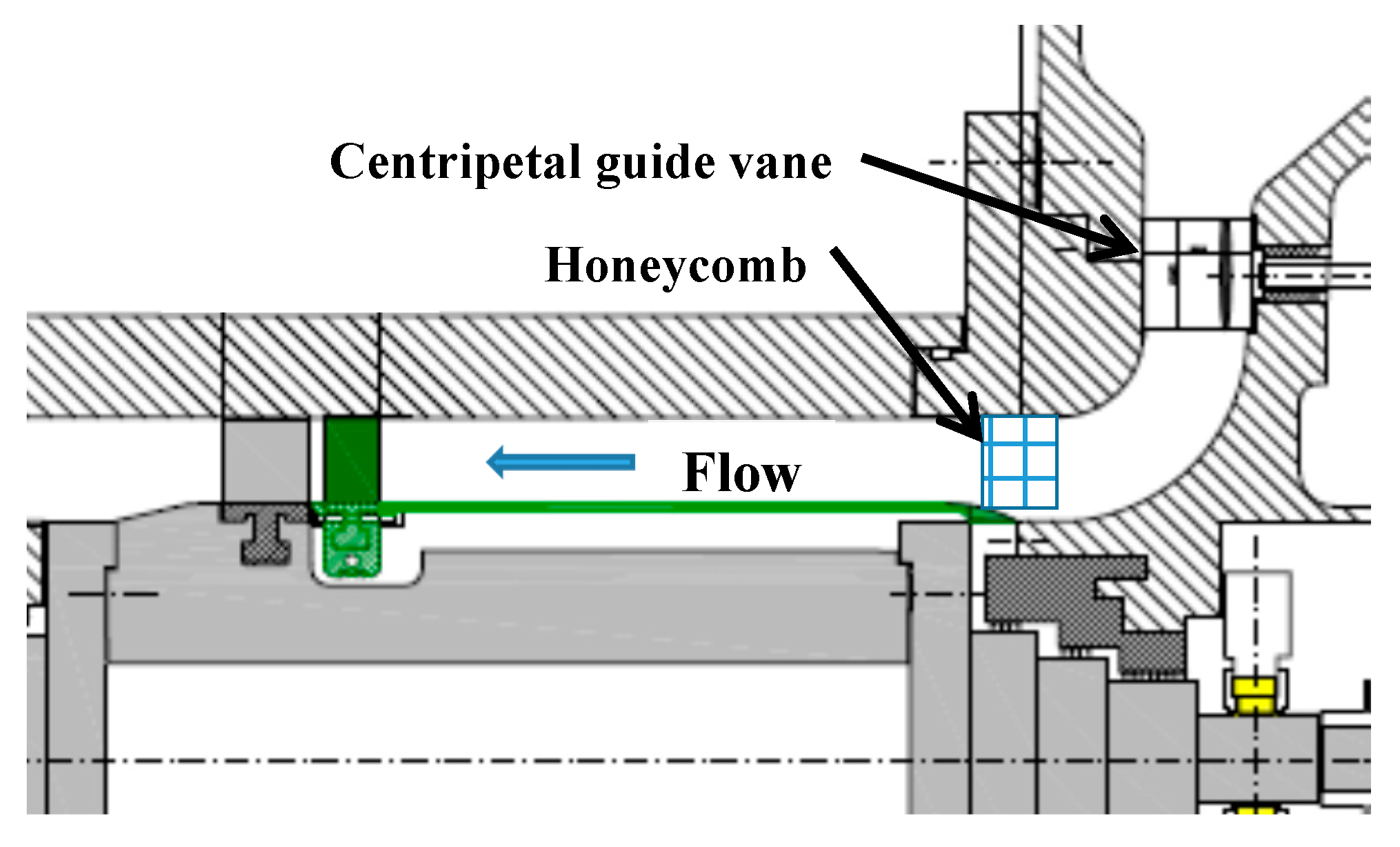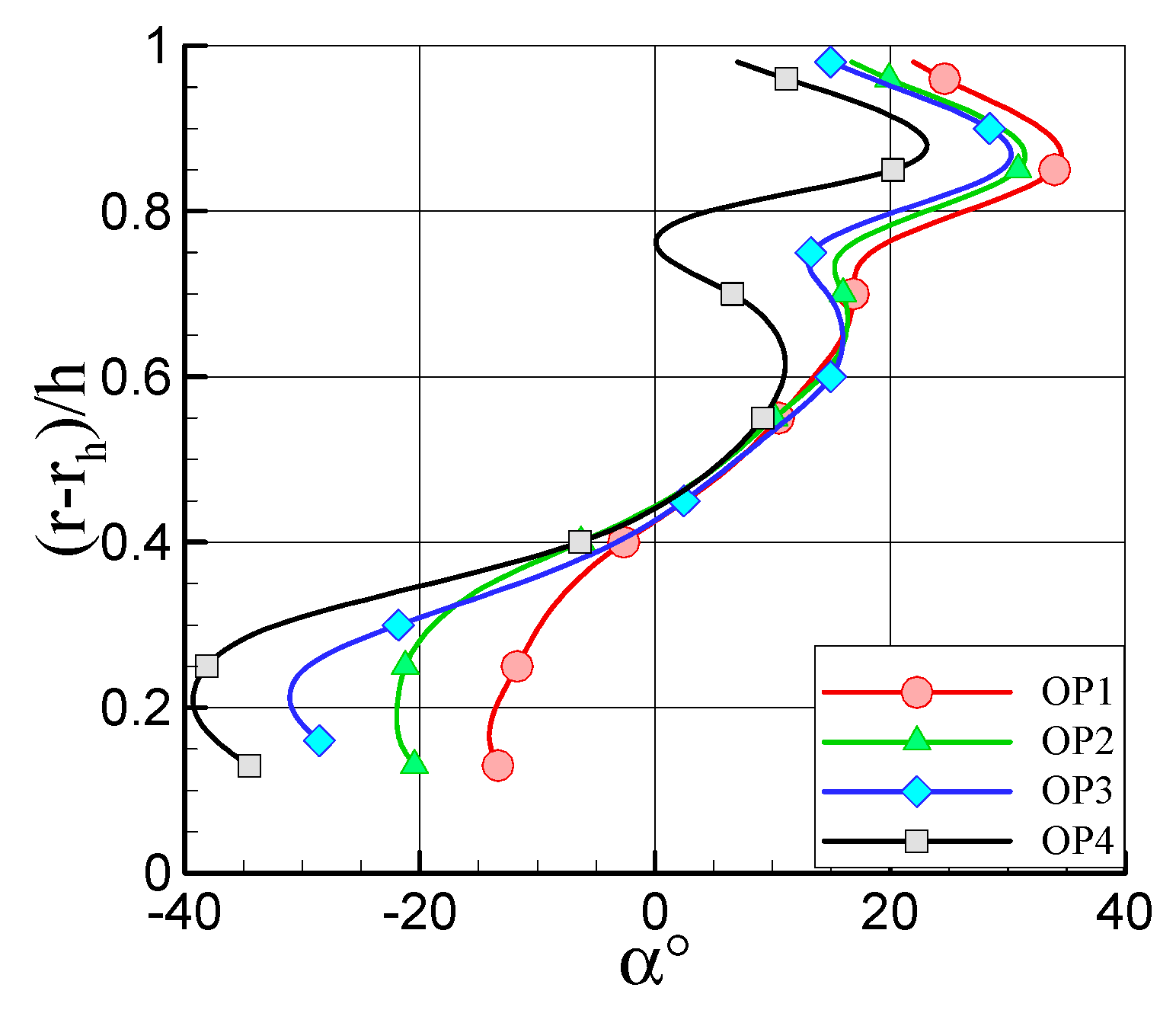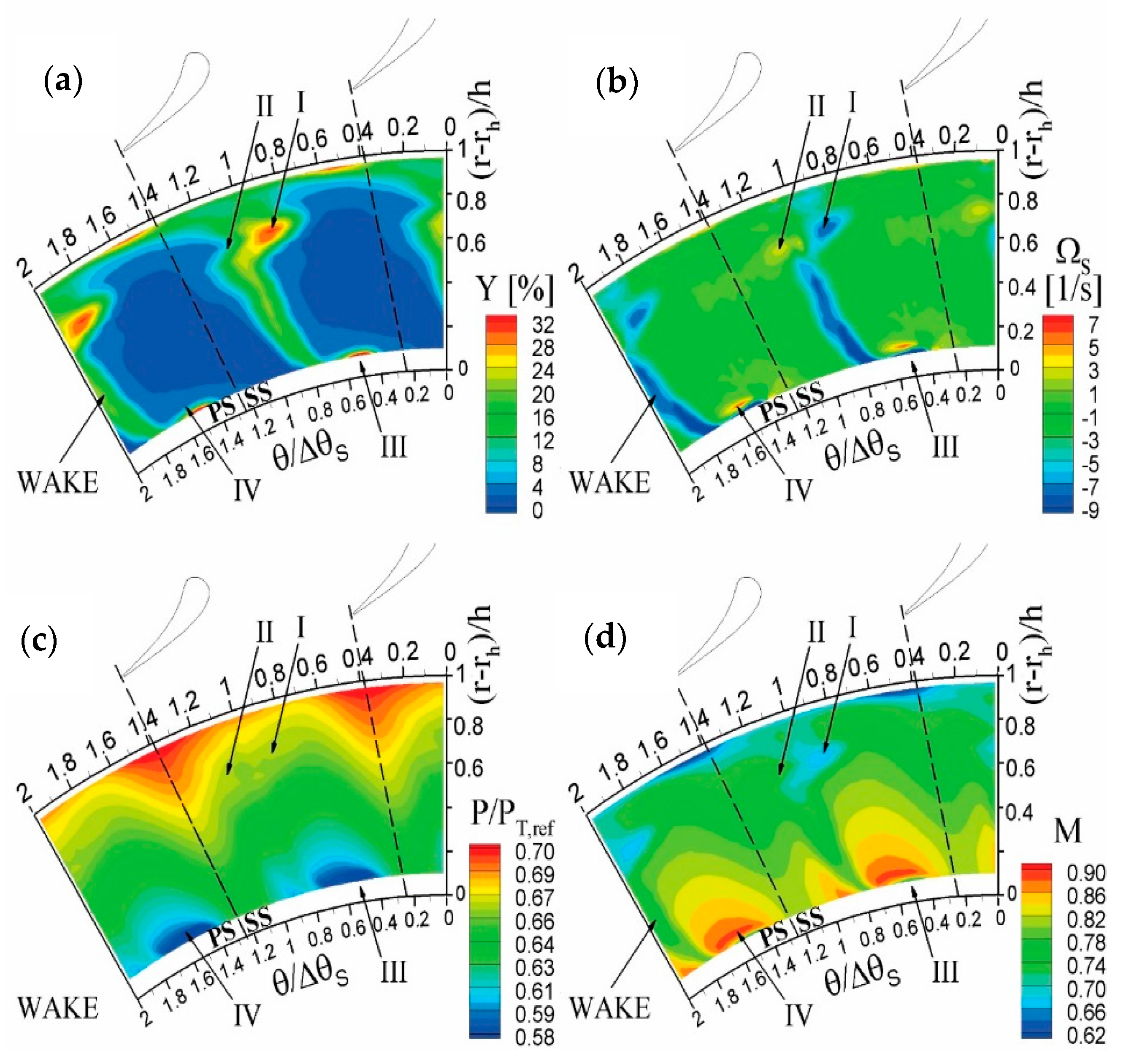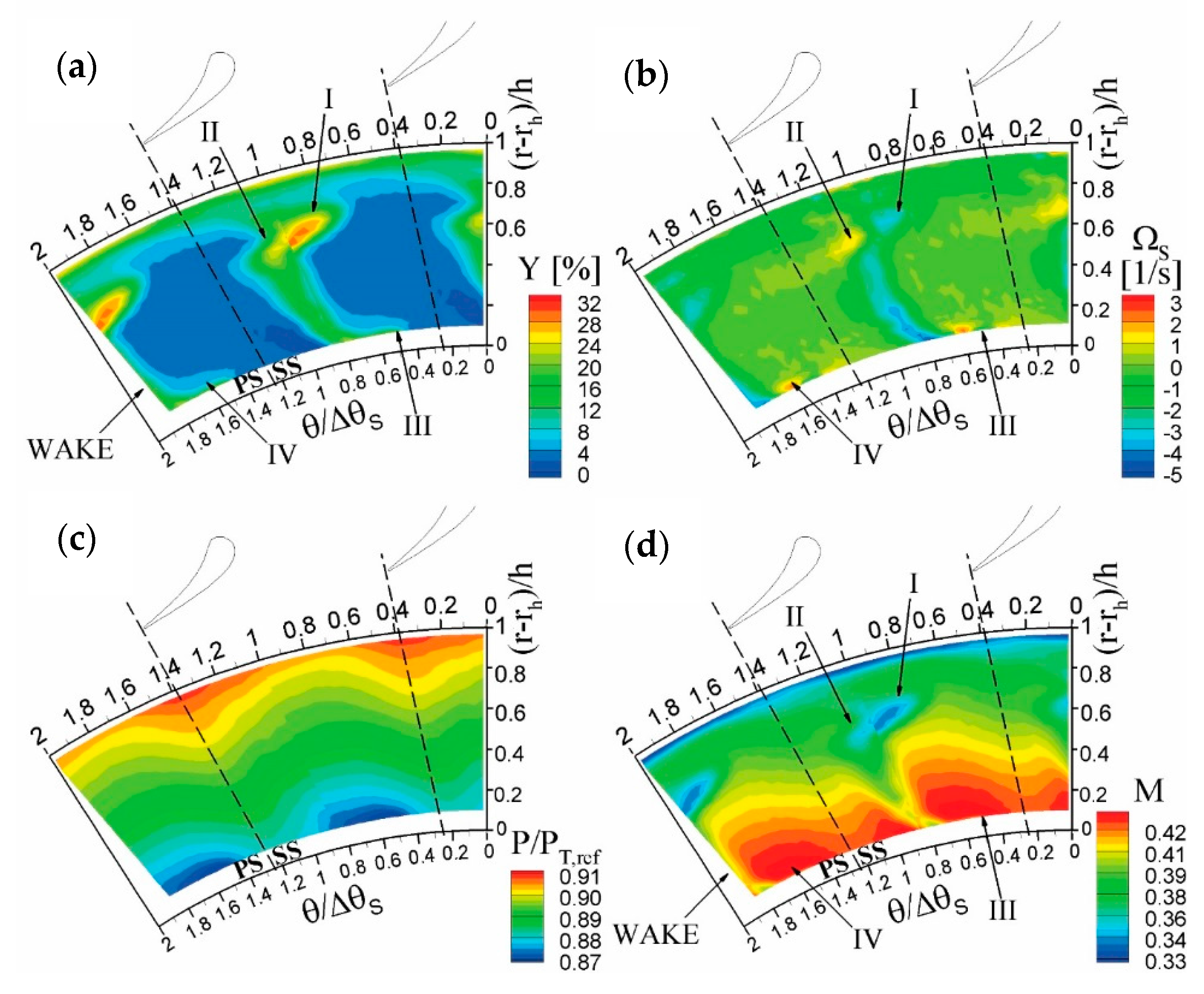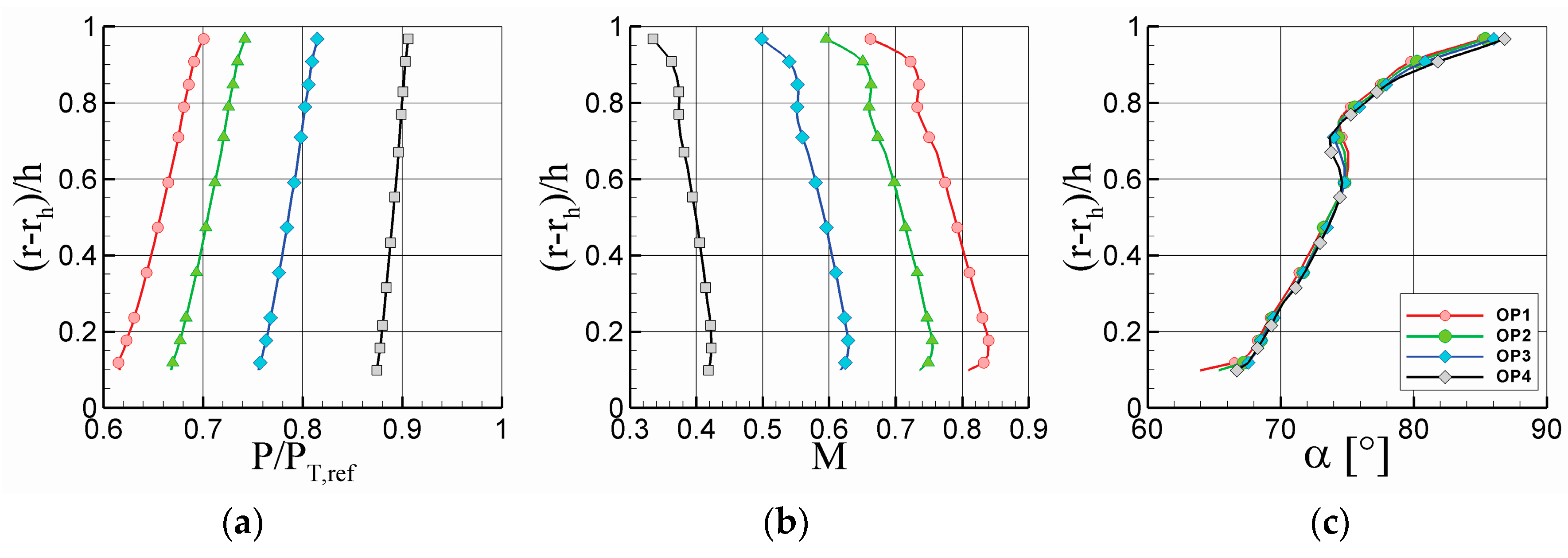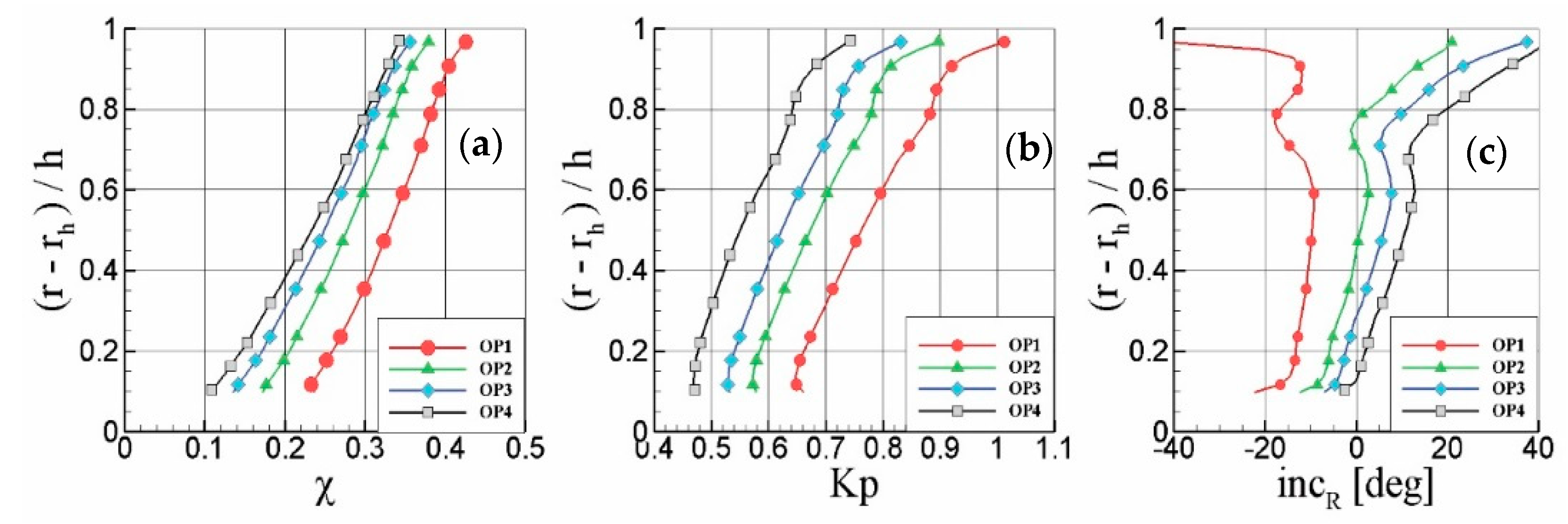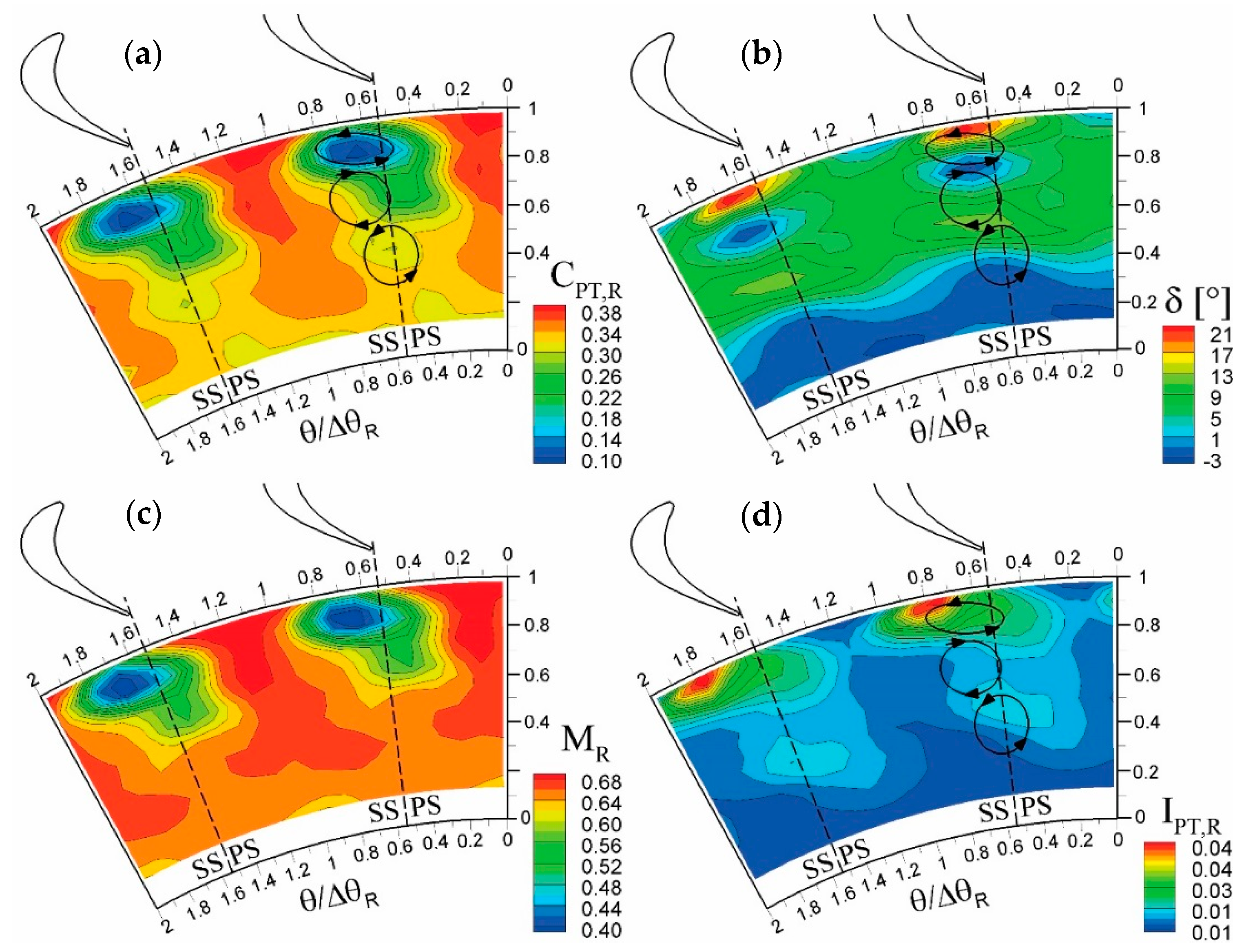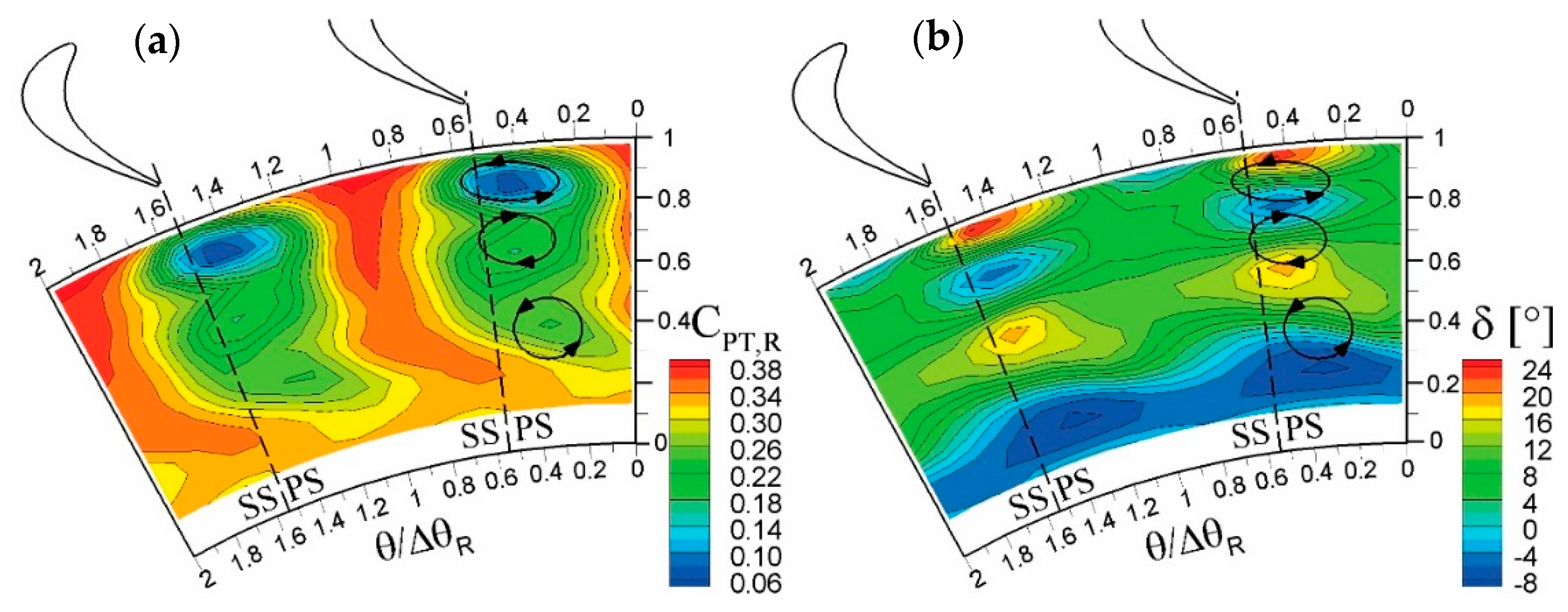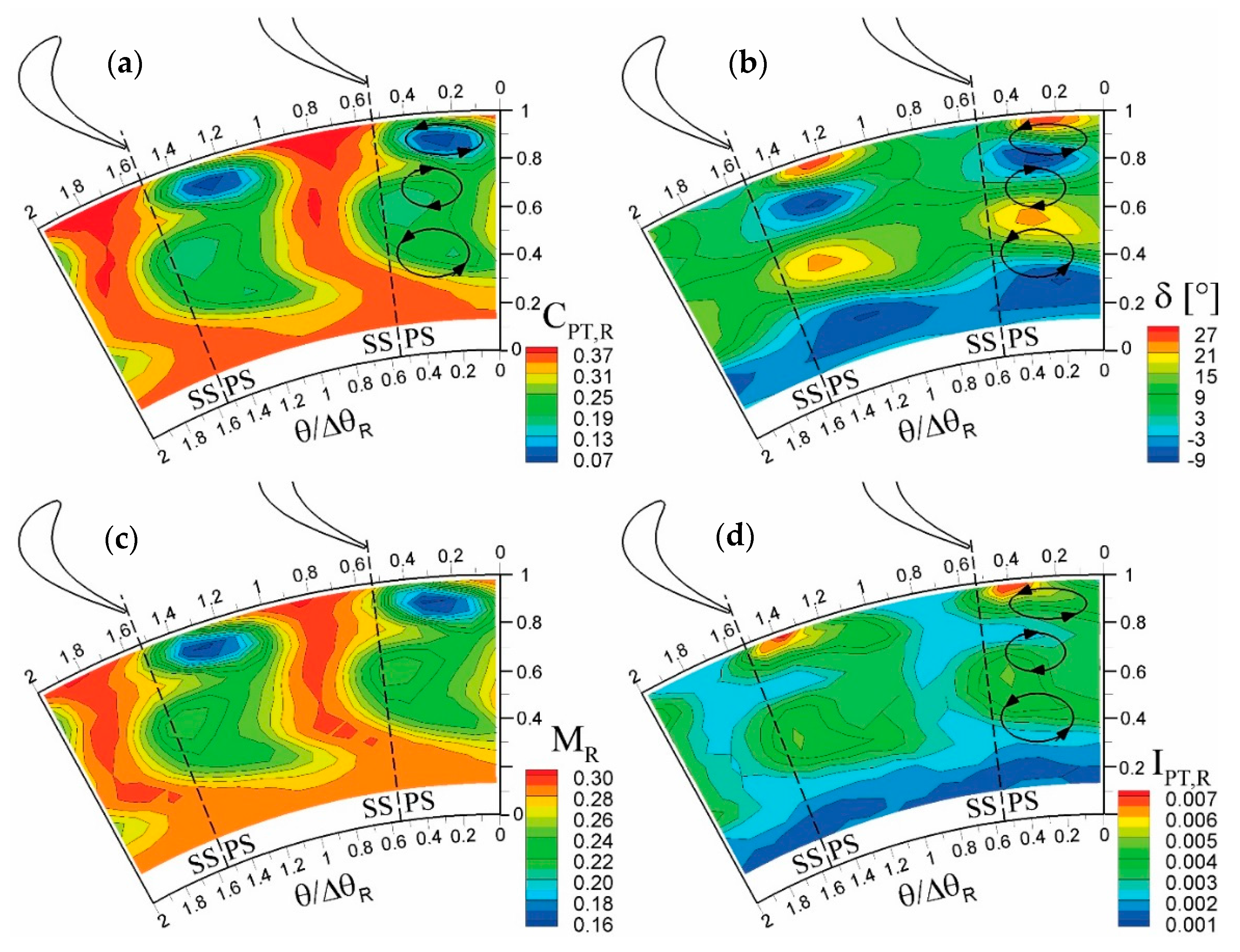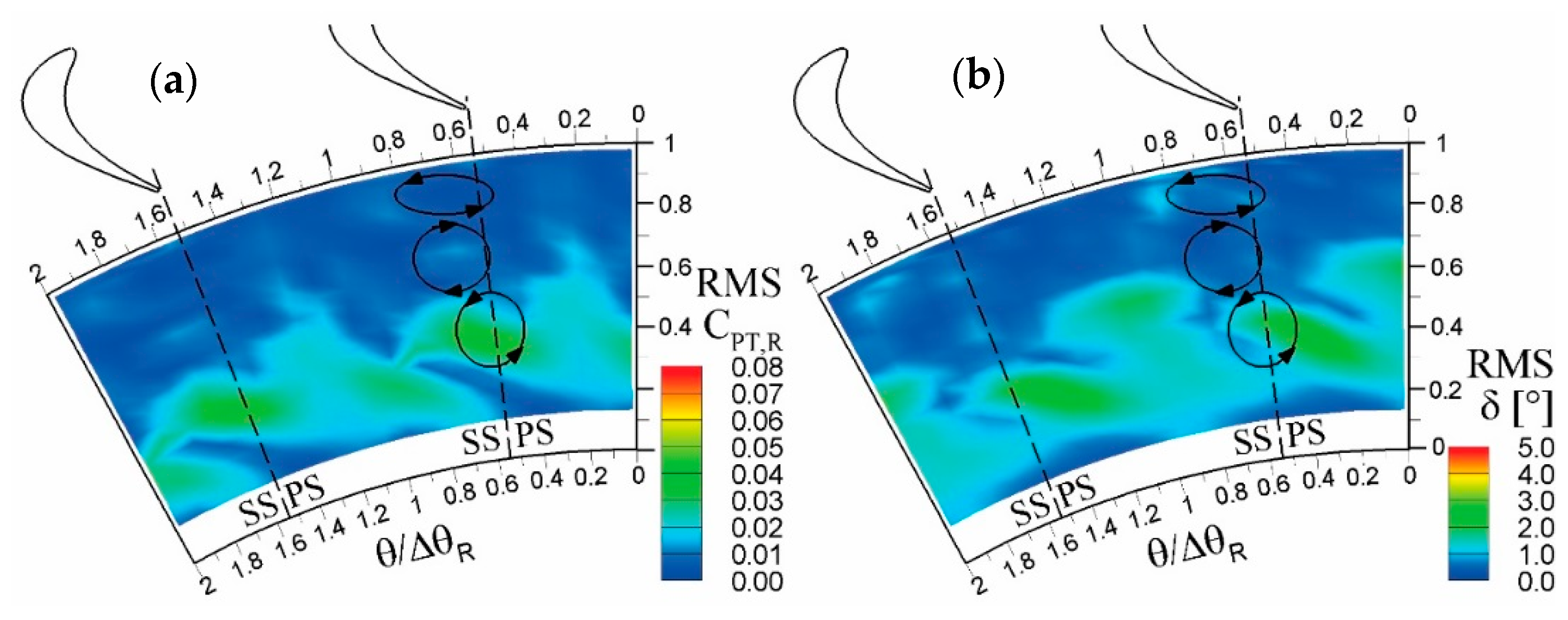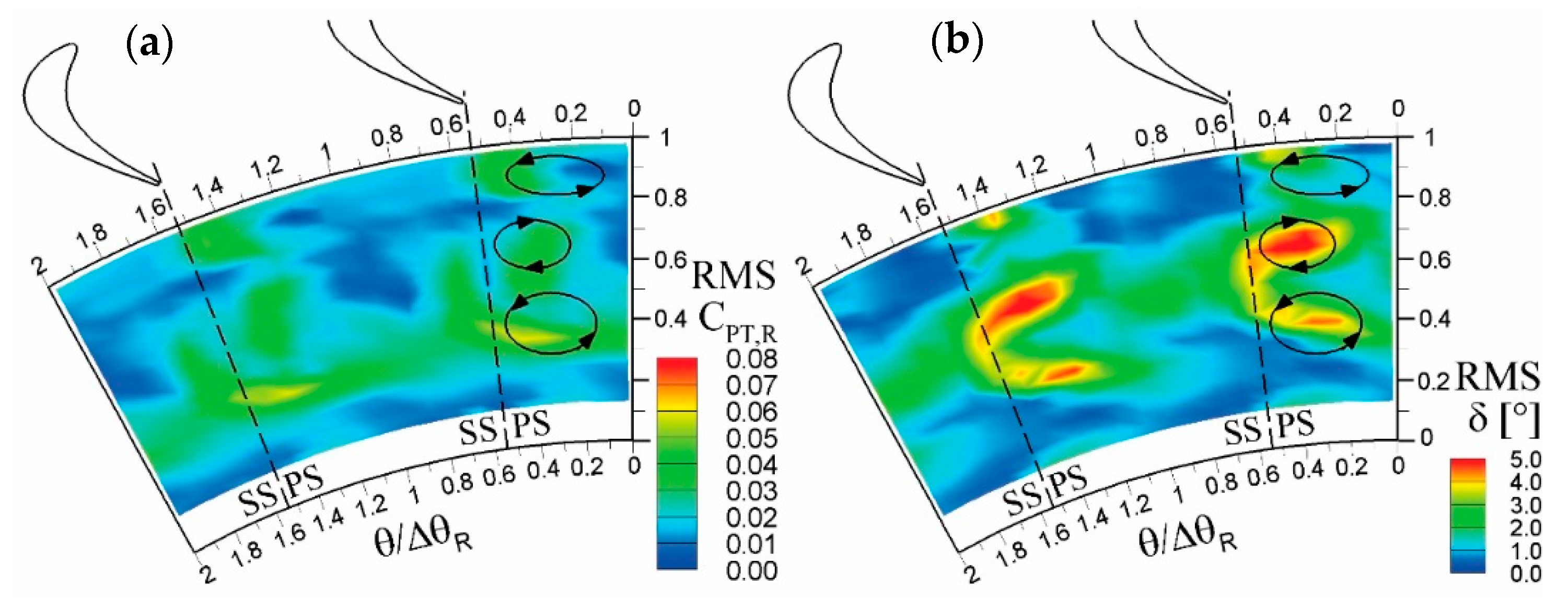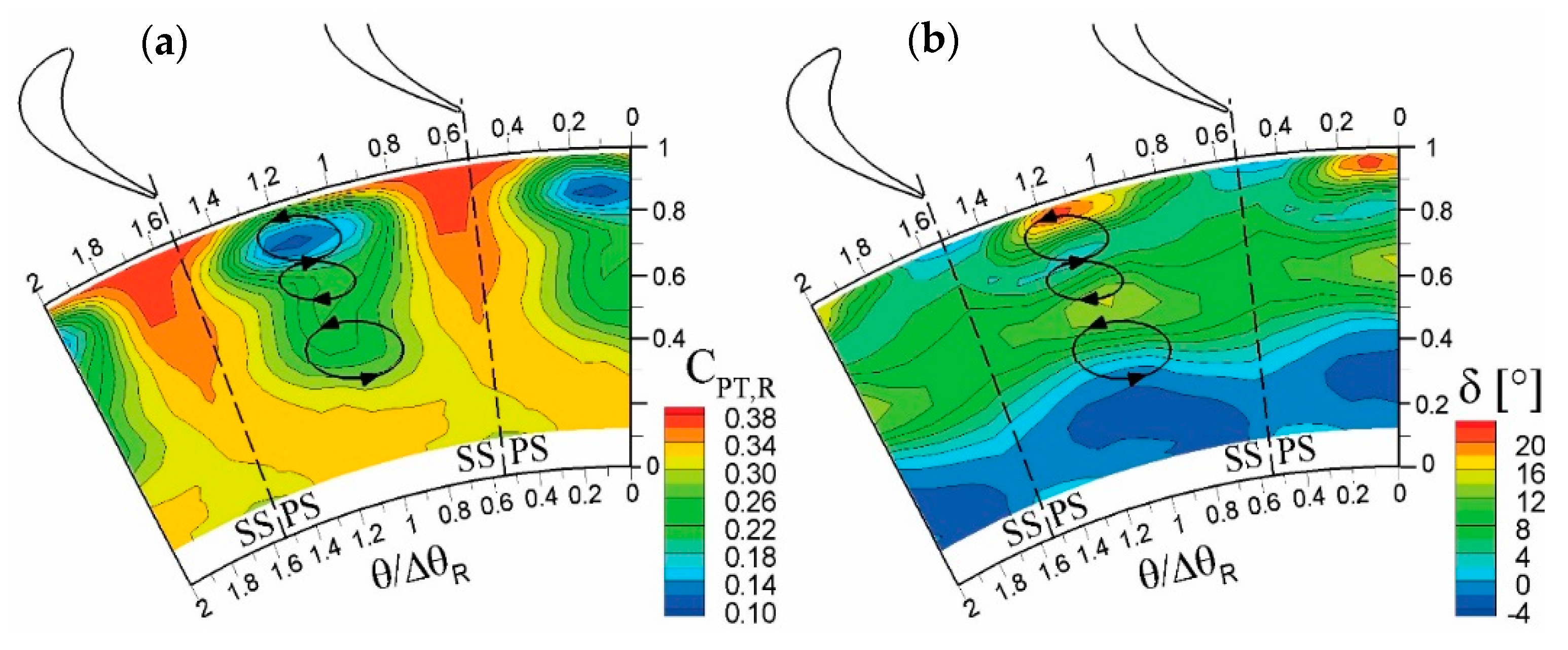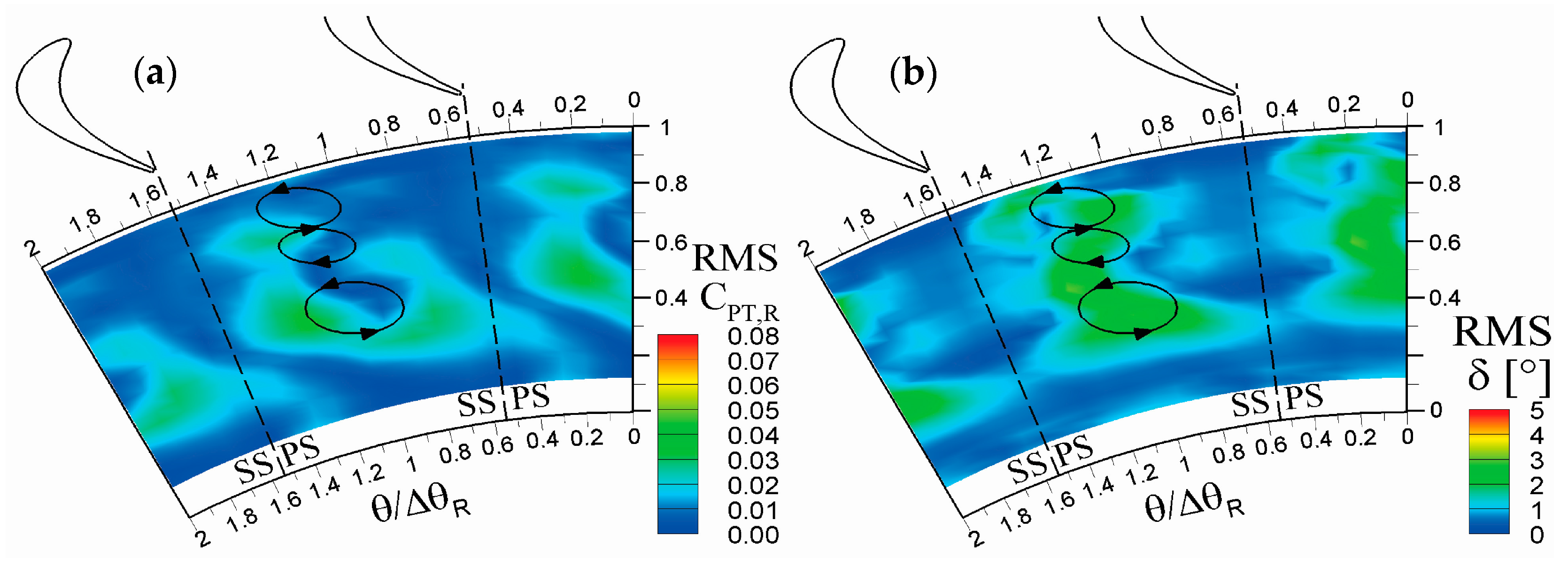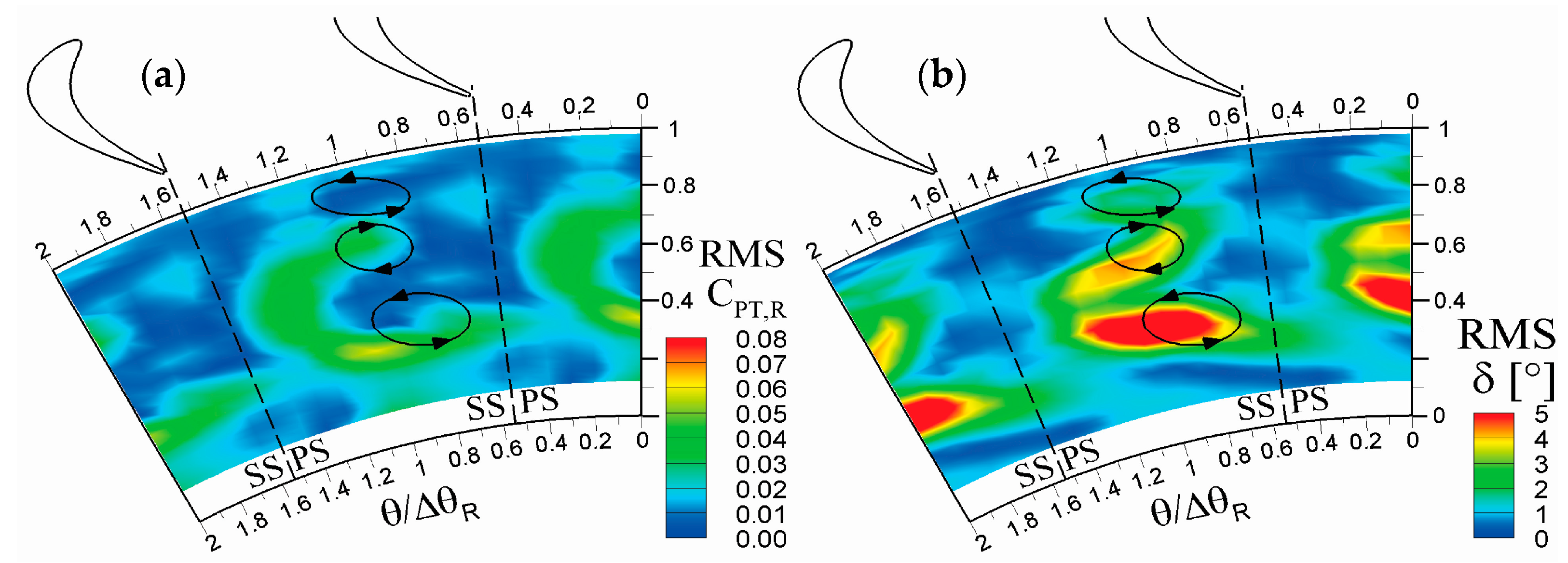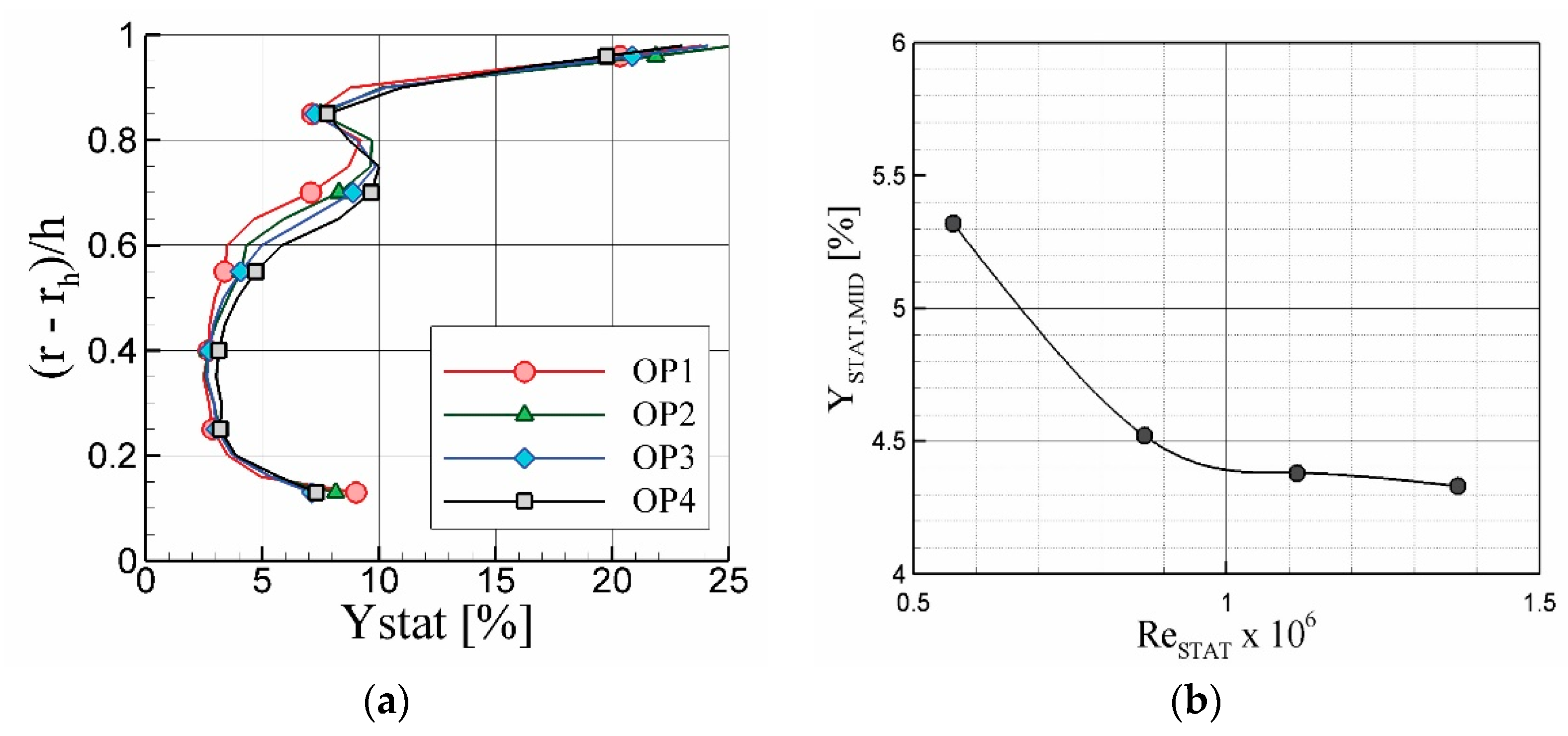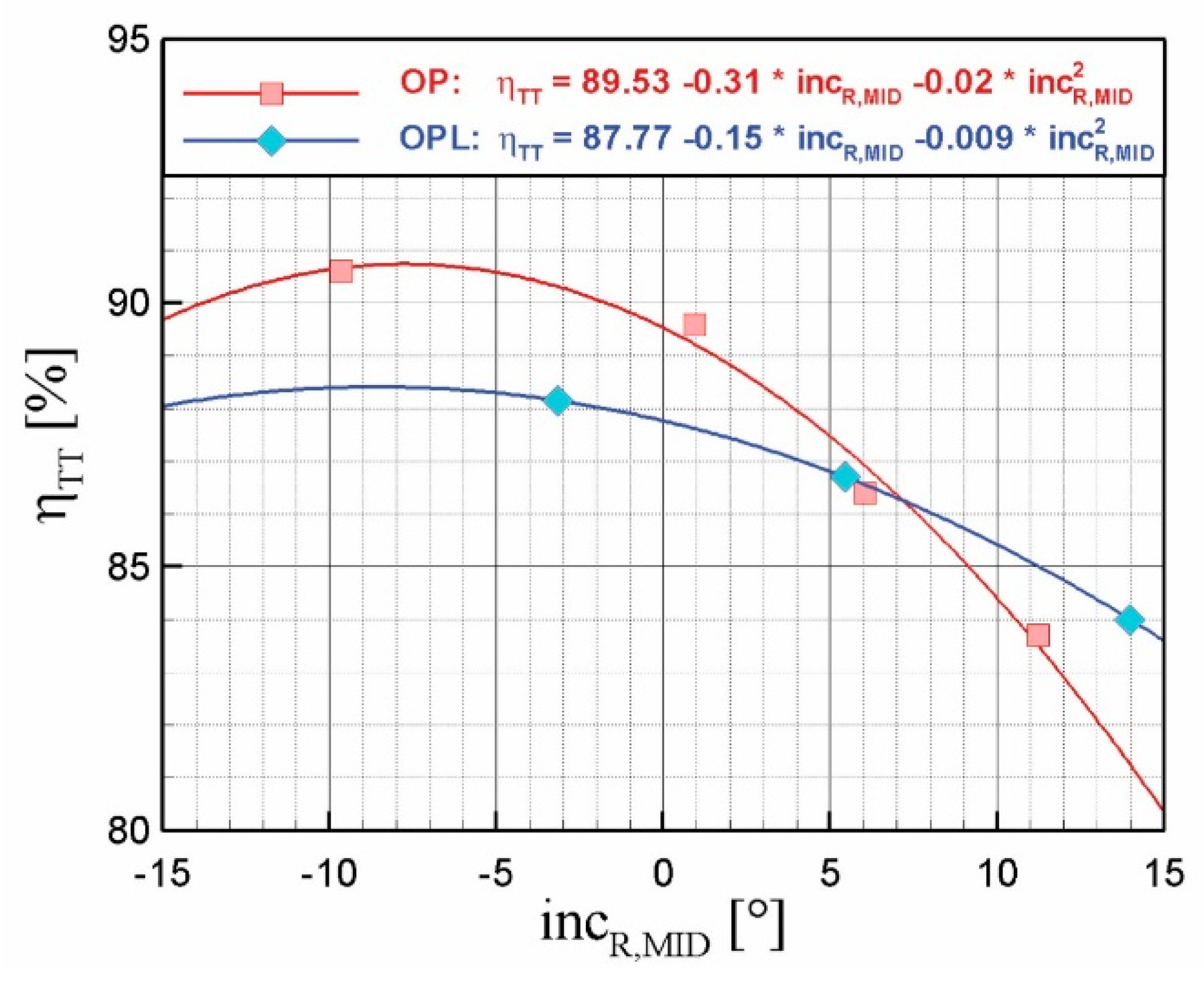This Section presents the experimental results for the different OP and OPL, first focusing on the effect of expansion ratio, both in the inter blade region and downstream of the rotor. To isolate the loading effects, OP3U and OP3L are then presented and discussed in comparison with the other OP.
4.1. Inter Blade Row Flow Field for Different Expansion Ratios: OP1–OP4
In this section, the flow field in-between the blade rows is discussed for the four operating conditions, to provide an overview on the aerodynamics of the stator cascade and a reference for the subsequent discussion of the rotor-exit flow field.
An overview of the stator-exit flow in transonic conditions (OP1) is shown in
Figure 3 in terms of distributions of total pressure loss coefficient, Mach number, static pressure and stream-wise vorticity. The distributions of loss coefficient and Mach number show highly non-uniform flow in both pitch-wise and span-wise directions. The vane wake can be clearly identified in the loss distribution, enlarged by concentrated loss cores at 75% span and at 15% span. These concentrated loss cores roughly correspond to the secondary vortices, whose magnitude and orientation are marked by the stream-wise vorticity distribution. Two vortices appear in the tip region, namely the passage vortex (core I, negative) and the associated trailing edge shed vorticity (core II, positive). In the hub region, a weak passage vortex (core IV, positive) is found, while the trailing shed vorticity is smeared along the wake; at the bottom of the map the strongest hub vortex is found (core III, negative), which can be identified as a strong hub corner vortex.
The Mach number and static pressure distribution also show large pitch-wise gradients, because of the vane potential field propagating downstream, and large span-wise gradients as a result of radial equilibrium. The combination between the two pressure fields leads to highest expansion ratio in the hub region (as visible in the static pressure map) inducing transonic flows at the bottom of the measurement area. At the left edge of this low pressure region, high pressure gradients are found, which are probably the trace of a weak shock wave generated on the rear suction side of the blade.
By operating the turbine at the lowest expansion ratio (OP4), a similar flow pattern appears, with some relevant differences (
Figure 4). Alongside the relevant reduction of peak Mach number, which goes down to ~0.4, the wake appears significantly wider than that for OP1. This can be explained by resorting to the classic Mach and Reynolds number effects on an accelerating boundary layer where a higher acceleration tends to reduce the boundary layer thickness, and hence the thickness of the wake in transonic condition. The Mach number affects significantly the secondary flows, too; in the tip region for OP4, the vorticity distribution shows vortices with half of the magnitude with respect to that found at OP1; correspondingly, a wider secondary loss core is found for OP4 that evidences more smeared secondary flows in OP4 on the measurement traverse, thus suggesting a faster mixing process at low Mach number. In the hub region, the shed vorticity in the wake and the passage vortex (IV) can still be easily identified, though being very weak; the corner vortex, instead, is not even visible on the measurement plane. All these features are consistent with a reduction of the cross passage pressure gradient connected with a reduction in the expansion ratio. What above described can be referred to, as done in the following, as “direct” Mach and Reynolds number effects.
A synthetic overview of the flow field downstream of the stator is provided by the span-wise profiles of pitch-wise averaged quantities, reported in
Figure 5 for all the OP. The pressure and Mach number profiles clearly show the different flow regime for the different conditions, even though they provide similar trends. The relevant impact of radial equilibrium is clearly visible, motivated by the relatively large shape factor (
h/
Dmid) of the present cascade. The flow angle distributions show significant span-wise variations, caused by the twisted and leaned shape of the stator blade; local gradients appear superimposed over the main trend, in correspondence of secondary flows. Interestingly, the mean flow turning imposed by the cascade appears virtually independent of the operating condition, demonstrating the insensitivity of the stator deviation angle on the Mach and Reynolds number and hence on the expansion ratio.
To further investigate the impact of the different OP on the overall stage behavior,
Figure 6 reports some global stage parameters, namely the velocity coefficient
Kp and the reaction degree
χ. A significant radial variation is found for all the OP, driven by the radial equilibrium established at the cascade exit by a high flow turning and a high blade height to mean diameter ratio. The comparison among the trends measured for the different OP marks a large quantitative change with the stage expansion ratio. This effect is actually stronger in the stator, due to the low reaction degree of the present stage, which makes the Mach number to be higher in the stator than in the rotor for any OP. As the compressibility effects do not alter the stator-exit flow angle (
Figure 5), the change on the
Kp is only due to change in absolute velocity magnitude not proportional to the peripheral speed one. In fact, considering midspan as the reference radial position, from OP4 to OP1 the rotational speed has been increased by 2.7 times, while the absolute velocity only by a ratio of 1.9. The reaction degree increases as the expansion ratio grows from OP4 to OP1, highlighting the nonlinear relationship between the expansion ratio and the resulting velocities.
As a consequence of all the changes acknowledged for the different OPs, the incidence angles experiences a large variation. For OP4 it is mainly positive (at midspan ≈ +10°) and moves to negative values for OP1 (at midspan ≈ −10°), being almost null for OP2. To this trend, a span-wise variation is superimposed due to the strong radial equilibrium effects and to the action of the secondary vortices. Peculiar behavior is shown in the tip region where the casing boundary layer and the secondary flows heavily reduce the outlet kinetic energy (see losses in
Figure 3 and
Figure 4), generating a significant change in the relative flow angle, especially for OP1. This significant change in rotor incidence angle, acknowledged in the following as an “indirect” effect of the expansion ratio, is expected to have a severe impact on the rotor operation and in the stator–rotor interaction, as discussed in the following.
4.2. Rotor Aerodynamics
In this Section, the rotor aerodynamics are discussed on the basis of flow measurements at the rotor-exit for the different OP. To highlight the rotor flow features, the analysis is developed in terms of time-mean and fluctuating relative quantities, as perceived by a rotating observer integral to the rotor blades. This allows identifying the loss mechanisms and the vortex structures generated within the rotor blade row. On the methodology ground, it is worth noting that for time-mean rotor flow measurements an unsteady probe is required (the FRAPP), as the probe does not rotate integral to the rotor. In practice, the time-mean rotor-exit flow field perceived by a rotating observed was reconstructed starting from phase-averaged measurements taken in the stationary frame, converting them in rotating frame data and averaging them in phase (which means, averaged with respect to the different stator–rotor relative positions). The periodic unsteady fluctuations of the flow quantities are here defined as the differences between the mean and the instantaneous flows reconstructed in the rotating frame. For a rotating observer, any fluctuation over the mean value can be caused by the vane–rotor interaction only, and its magnitude marks the relevance of the unsteady coupling between the blade rows. To quantify the interaction, the root mean square of this fluctuation (RMS) was evaluated and it is shown in the present Section for different OP and reference as periodic unsteadiness. Coupled to the periodic unsteadiness, also the unresolved unsteadiness of the relative total pressure (
IPT,R) was calculated according to the methodology presented in [
30]. This quantity is defined for each stator–rotor interaction phase and for each grid point and it has been shown to be a proficient marker of high turbulence intensity regions, such as wakes and vortex structures (see [
13,
20] as application examples).
The discussion on the rotor aerodynamics starts from the mean rotor-exit flow field for transonic operating condition (OP1,
Figure 7), in terms of relative total pressure coefficient, rotor deviation angle, relative Mach number and unresolved unsteadiness. Low relative total pressure marks loss regions, while strong span-wise gradients in relative flow angle allow for the identification of the whirling structures (by resorting to the Rankine vortex model).
For transonic condition (OP1,
Figure 7), some general features of the flow in this rotor can be recognized. First considering the distribution of relative total pressure coefficient, a large loss region affects the top half of the channel: in particular, the huge loss core close to the tip is consistent with the leakage flow, which originates from a tip gap equal to 1.3% of the blade height. Below midspan the gradients connected to the wake are significantly smeared, resulting in an almost uniform flow field. This general feature is even more evident in the Mach number distribution, which is almost wake-free below 60% span.
The distribution of the rotor deviation angle exhibits large local spanwise gradients, with significant under-turning (δ > 0) above 40% span and a weak over-turning (δ < 0) in the hub region. Superimposed to this trend, three local regions of high flow angle variation are clearly visible, corresponding to three vortex structures placed on the suction side of the wake. The tip vortex centered at 90% span, where the maximum velocity deficit is found, is by far the largest structure appearing on the measurement plane and it is caused by the leakage flow. Below this structure two counter-rotating vortices are found, centered at 70% and 40% span, which can be identified as the tip and hub rotor passage vortices, respectively. The migration of the hub vortex close to midspan is motivated by the very high flow turning of this rotor (120°) and by the Coriolis force; corresponding to the hub vortex, a local loss increase is observed. Conversely, the tip passage vortex appears considerably weaker, and its trace into the loss distribution is entrained in the huge wake loss that affects the outer part of the channel. The map of unresolved unsteadiness (
Figure 7d) confirms that the most relevant turbulent structures occur in vortex regions at the tip and at midspan. In particular, the highest turbulence is found on the left side of the tip leakage vortex, where the shear layer between the jet leaking through the cascade and the main flow rolls up in a vortex.
When the stage is run in subsonic conditions, represented in
Figure 8 and
Figure 9 for OP2 and OP3, respectively, the general flow configuration is similar to that found for OP1, even though the magnitude of the main flow structures changes significantly.
Figure 8 and
Figure 9 show that the velocity deficit in the wake is now significant all along the span (at least above 20% span), while the tip leakage losses are less sensitive to the operating conditions. In OP2, the loss region extends up the hub, assuming an almost straight shape, even though a reduction of loss is observed from tip to hub. In OP3 the loss region enlarges significantly and appears bent towards the suction side of the channel below 30% span; this is probably connected to the over-turning measured in this region, that appears enhanced for OP3 with respect to OP1 and OP2. Correspondingly, the tip and secondary vortices grow progressively as the stage expansion ratio reduces. Where the vortices magnitude appears increased, corresponding loss cores are found in the
CPT,R distribution. As a result, for these conditions the wake and the tip leakage vortex are not the main loss mechanism, and the dissipation connected to the secondary flows contributes significantly to widen the low
CPT,R region. For OP3, in particular, the passage vortex regions identify exactly two loss cores; the very large passage vortices, migrated towards midspan, occupy entirely the central part of the channel and make the loss region to be wider in the midspan region.
In terms of flow angle (
Figure 8b and
Figure 9b), the tip leakage vortex retains the features observed in OP1, while the magnitude of the passage vortices appears enhanced in subsonic conditions, as commonly found in literature about the Mach and Reynolds number effects on secondary flows [
26]. It is also of interest to note that the position of the wake and vortices slightly change with respect to those in OP1, as a consequence of the different flow evolution downstream of the rotor, already depicted in
Figure 2.
These phenomena appear dramatically amplified for the lowest expansion ratio tested, OP4. Given the specific features of the flow in this condition, all the relative quantities are shown in
Figure 10. Except for the tip leakage vortex and its associated loss, that retain the character discussed for the other OP, the low relative total pressure and relative Mach number region in the central part of the channel are greatly enlarged, reducing the free-stream to a narrow area in-between the wakes. Secondary flows grow in both scale and magnitude, as a 30° variation of flow angle is measured in both the local passage vortex regions above and below midspan. In particular, the tip passage vortex undergoes the largest amplification passing from OP1 to OP4. This is consistent with the larger wake extension observed for all the OP above midspan, resulting in a huge loss core just above midspan. This peak loss area, combined with that of the tip leakage vortex, penalizes dramatically the rotor aerodynamic efficiency in the outer part of the channel. Coherently with the general increase in secondary flows, the cross-flow/overturning at the hub is also larger and induces a further pitch-wise deformation of the wake. The unresolved unsteadiness (
Figure 10d) also marks a general amplification with respect to the transonic case, with peaks in the wide loss regions in the central part of the channel, but also high levels in the free-stream all along the span (except below 20% span).
The strengthening of the viscous and vortex structures with the reduction of the expansion ratio is only partially caused by a direct Mach and Reynolds number effects. As discussed previously, the rotor incidence angle grows significantly as the expansion ratio reduces (see
Figure 6c), as a consequence of the constraint imposed on the stage-exit flow angle. The variation increases from hub to tip, and it is quantitatively relevant for the whole blade span, passing from 10° at the hub to 40° at the tip. For the transonic condition the rotor works with negative incidence all along the span, with a fairly uniform span-wise profile at −10°. This explains the relatively low magnitude of rotor secondary flows, especially the tip passage vortex, in OP1 with respect to the other conditions. For subsonic turbine operation, the incidence exhibits an increasing trend along the span, the profiles being roughly shifted with the OP2 condition centered to null incidence.
The combined changes in the incidence trend and in the mean incidence values contribute to justify the growth of the tip passage vortex between, especially, OP1 and OP2 conditions, as most of the difference in incidence occurs passing from these two OPs. The average incidence variation between OP2 and OP3 is much smaller (≈5°) and further reduces between OP3 and OP4 (< 5° on 110° of flow turning and a mean value of ≈10°). The comparison between the latter two subsonic conditions is particularly interesting as, for similar values of incidence, relatively large change in Reynolds and Mach numbers occur (the Mach number drops from 0.6 to 0.4 at the vane exit, and from 0.5 to 0.3 at the rotor exit; the midspan Reynolds number drops from 0.9 × 10
6 to 0.55 × 10
6 for the stator and from 0.5 × 10
6 to 0.3 × 10
6 for the rotor, see also
Table 5). Hence, the differences between OP3 and OP4 mostly depend on Mach and Reynolds numbers of the rotor profile.
Based on the present measurements, the impact of Reynolds/Mach numbers is shown to be large in the turbine under investigation. In fact, the general flow topology is preserved (see
Figure 9 and
Figure 10), but both the extension of the loss region and the magnitude of the passage vortices are greatly amplified at low Reynolds/Mach numbers. In OP4 the higher relevance of viscous stresses and the lower flow acceleration connected to the nearly incompressible flow regime both contribute to enlarge the boundary layers, resulting in wider wake and secondary flows.
The expansion ratio has also an extremely significant impact on the vane–rotor interaction, which is here discussed by resorting to the periodic fluctuations in the rotating frame.
Figure 11 and
Figure 12 show the distribution of periodic unsteadiness (in terms of RMS) of C
PT,R and δ for OP1 and OP4 to provide a synthetic view of the flow regions affected by the highest unsteadiness. To aid the reader in the interpretation, the positions of the three main vortex structures are also marked in the figures.
OP1 condition does not exhibit any visible effect of interaction above midspan, where a wide wake, a strong tip leakage flow, and a weak tip passage vortex determine the flow topology. Conversely, the effects of the vane–rotor interaction are well visible below midspan, and especially in the core of the hub passage vortex. Relative total pressure fluctuations affect most of the channel between 30% and 50% of the span; this indicates that the rotor wake below midspan, even though appearing weak on a time-averaged basis, is actually a highly unsteady structure. The high RMS level in the free-stream region in-between the adjacent wakes (θ/Δθ
R = 1), is probably connected with the convection of the stator wake within the rotor. The periodic RMS of the flow angle shows a similar trend with a peak value in the core of the hub passage vortex and a second interesting peak in the free-stream at midspan. This feature was already observed in previous investigations on this turbine [
11,
13], and marks the presence of vortex–blade interaction, namely the transport of the vane secondary vortex filament throughout the rotor channel and its release at the rotor exit.
OP4 condition exhibits a completely different amplitude and pattern of periodic unsteadiness. At first, large fluctuations are found also above midspan, thus affecting the whole viscous/loss region identified on a time-averaged basis. Interestingly, below 30% span, where the rotor wake/loss region is mixed-out (see
Figure 10a), also the unsteadiness decays completely. This suggests that, beside wake-blade interaction effects, for OP4 condition the rotor wake in itself is pulsating. Considering the flow angle unsteadiness, in this case all the three vortices undergo periodic fluctuations (even though the tip leakage vortex exhibits the lowest unsteadiness). The tip passage vortex now exhibits the largest unsteadiness, while being virtually steady in transonic condition (OP1). Vortex–blade interaction features are still visible in the free-stream, but the corresponding flow angle oscillations are much weaker than that detected in the core of the passage vortices. As a result, the dominating source of unsteadiness is not the transport of vane-exit vortex structures, but the pulsation of the rotor vortices, as already observed for the wake.
The periodic pulsation of rotor viscous structures arises as a consequence of the pitch-wise gradients in vane-exit flow field, which act as periodic fluctuations in the rotor-inlet flow field. As the blade sweeps in front of the stator wake and potential field, the rotor incidence angle and the rotor inlet relative Mach number fluctuate modifying periodically the rotor aerodynamic loading. Considering the axial gap set for the present investigation, the effect of potential field is mostly decayed at the rotor inlet, hence the vane wake is the main source of unsteadiness in the rotor aerodynamic loading. In transonic conditions (OP1), as negative incidence takes place, the comparison between velocity diagrams in the wake and in the free-stream produced a relatively small incidence angle variation. This explains why most of the unsteadiness in OP1 is caused by transport of viscous structures. Conversely, in OP4, the configuration of the velocity diagram and the wake velocity deficit amplifies the rotor incidence fluctuation, resulting in a severe oscillation in rotor aerodynamic loading.
It can be concluded that, in the present turbine, the rotor aerodynamics are highly penalized by a reduction of the expansion ratio, both in terms of loss generation and aerodynamic forcing. However, it is of particular interest to investigate the actual physical motivations for the observed features, as the change in the expansion ratio alters the relevance of compressibility effects, of viscous effects, as well as of loading effects. To shed some light on this issue, a dedicated analysis is reported in the following subsection on the effects caused only by the rotor aerodynamic loading on the aerodynamics of this turbine.
4.4. Stage Performance Data
To quantify the weight of the direct effect (due to Mach and Reynolds numbers) with respect to the indirect one (related to the rotor incidence), the stator aerodynamic loss and the overall stage performance are now discussed. Stator losses are expresses by the total pressure loss coefficient (Ystat) while the stage performance is expressed by resorting the stage work, calculated by means of the velocity triangles, divided by the total-to-total isentropic enthalpy drop.
Results are reported in
Table 5, alongside the chord-based stator and rotor Reynolds numbers, the Mach numbers downstream of the stator and rotor, and the rotor incidence angle at midspan (the latter being a marker for the rotor loading condition).
First considering the OP, the stator total pressure losses (
Ystat) clearly mark the effects of the expansion ratio according to what commonly found in literature on the Mach number effects on secondary flows [
26].
Figure 17a shows their spanwise trend with peaks at tip and hub whose intensities decrease as the Mach number increases.
When the profile losses—evaluated at midspan—are of concern (
Figure 17b), a decreasing trend is also found; the loss trend is consistent also with typical Reynolds number effect, which foresees a decrease in friction coefficient as the viscous effects reduces their importance with respect to the inertial one. The limit Reynolds number is located around 10
6, where the function assumes an asymptotical trend to the value of ≈ 4.35.
In a nutshell, the midspan losses seem to be more related to the effect of Reynolds number than to that of the Mach number on the blade boundary layer.
OPLL and OPLU being different from OPLR only for the rotor rotational speed, they do not evidence any significant difference in the stator flow and for this on its loss coefficient.
When the effect of stage expansion ratio is of concern, data from
Table 5 can be more proficiently analyzed by considering the trends reported in
Figure 18, where the total-to-total efficiency is plotted against the incidence angle at midspan, which is taken as indicator for the rotor loading. In general, a decreasing trend is found as the incidence angle increases but some differences appear between the two sets of test OP and OPL.
In the incidence range where the data from the data-sets are comparable (−5 < IR,MID < 15), the two curves have different slopes; OPL tests, that only feature a change in rotor loading with negligible variation in Reynolds and Mach number, exhibit a smaller slope. On the contrary, in OP tests, where both the direct and indirect effects are present, the efficiency is reduced by both the loading effects and by the Mach/Reynolds ones, all of them playing the same role. It is to be noted that the two data sets are quantitatively coherent, as the OP3 and OPLR conditions show a very good repeatability.
In order to provide a quantitative perspective on these effects, the stage performance in an incidence angle range within ±6° with respect to the reference condition OP3 is now considered.
For positive incidence levels with respect to the reference condition, the lower performance of the stage in the OP4 test with respect to the corresponding OPLL (for example: ηTT,OP3L − ηTT,OP4 ≈ 1% for IR,MID = 11°) has probably to be ascribed to the lower Reynolds and Mach numbers experienced by the blade row for low expansion ratio.
On the contrary, for negative incidence levels with respect to the reference conditions, the higher stage performance in the OP2 test with respect to the corresponding OPLU test (for example: η
TT,OP2 − η
TT,OP3U ≈ 2% for I
R,MID = 1°) is promoted by the Mach and Reynolds number effects on the rotor induced by the higher expansion ratio (the Reynolds effect on the stator becomes negligible as shown in
Figure 17b).
The differences in this trend are related to the non-linear effect of the loading that, when positive, acts so to overshadow the Reynolds and Mach number effects.
